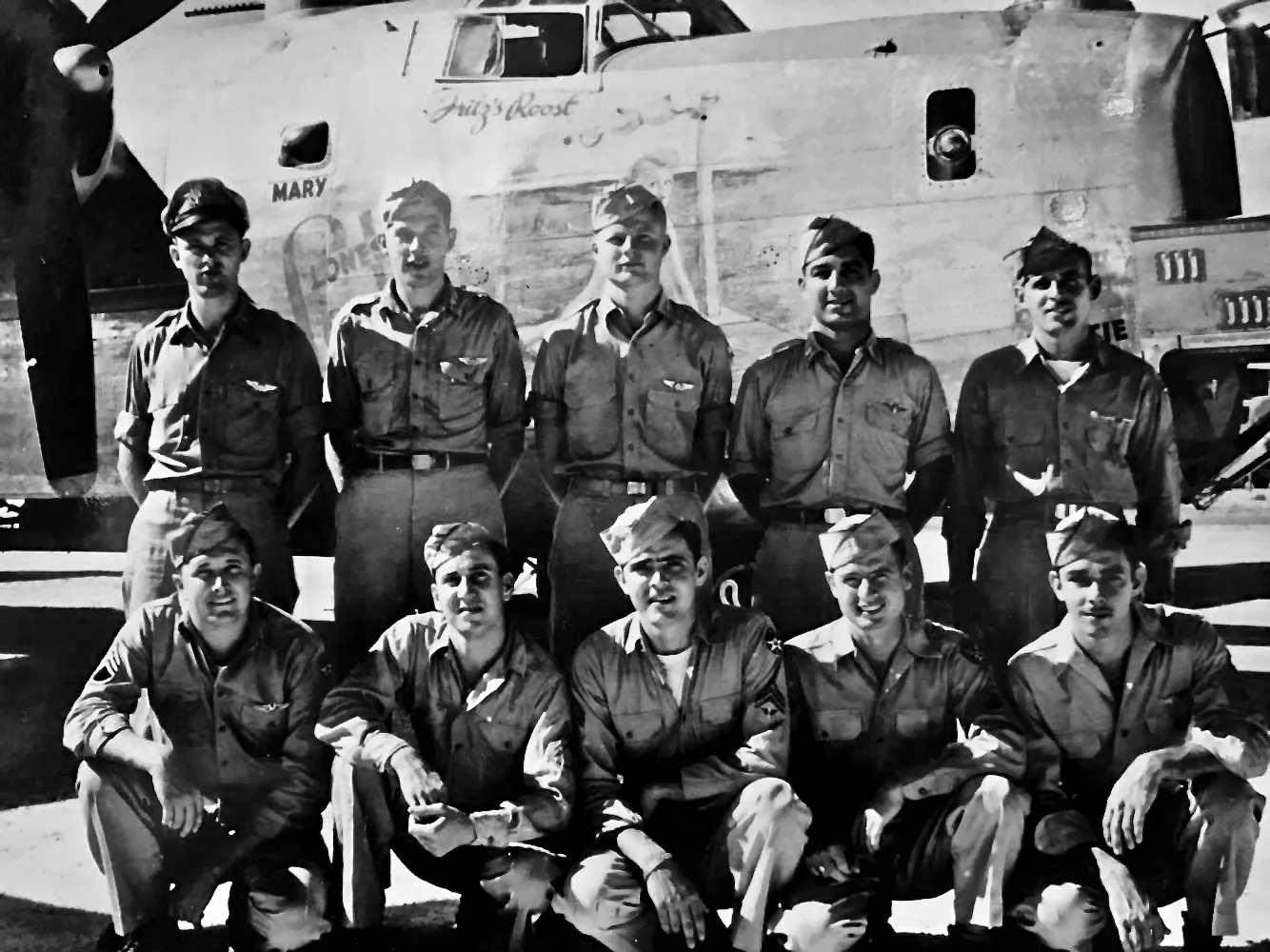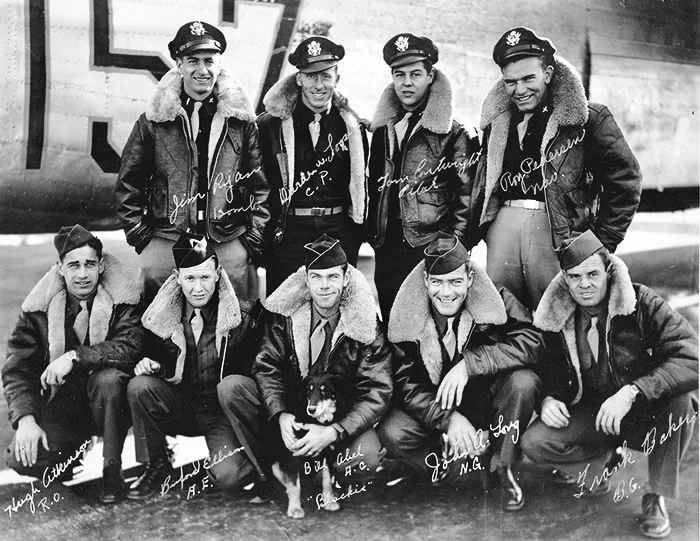Model B-24J-175, serial number 44-40680
Built in 1944 by Consolidated in San Diego, California, this plane was known as Model B-24J-175, serial number 44-40680. The Lonesome Lady was one of at least 28 B-24's that were assigned to the 866th Bomb Squadron of the 494th Bombardment Group of the 7th US Army Air Force. Likely beginning service on 29 May, 1944 in Mountain Home, Idaho, she was brought into the Pacific Theater of Operations by the crew of Pilot 2nd Lt. Emil Matthew Turek. The Lonesome Lady completed 46 combat missions beginning 22 November, 1944, and ending 28 July, 1945.
B-24 Lonesome Lady in flight on 11 April 1945 raid on Cotabato, Mindanao, Philippine Islands, from Angaur, Palau, Caroline Islands. Emil Turek and Fritz Johnson piloted this mission as part of the 7th Army Air Force, 494th Bombardment Group, 866th Squadron. The Lonesome Lady was shot down on 28 July, 1945 while bombing the Japanese Battleship Haruna, in Kure Harbor. Only the pilot, Thomas Cartwright, and Tail Gunner, Bill Abel, returned home from that mission. Six crew men died as a result of blast wounds and radiation from the atomic bombing of Hiroshima on 6 August, 1945. This footage was compiled into a larger presentation of 494th Group videos by Victory Film Productions, 2007.
"Nose art" was a beloved tradition in WWII and before. The "nose" of the B-24 fuselage “served as a broad canvas” for naming and decorating the plane. This photograph, probably the earliest known, was taken on a Hawaiian Island, before deploying to Angaur in the Palau Group of the Caroline Islands. It shows that the artwork was completed before Lonesome Lady was named.
Below: Nose art newly painted on the as yet unnamed Lady. Courtesy of the Turek family. This photograph reveals an additional crew tribute: "Flossie" appears here but is obscured in other photos. Navigator Rolf Slen confirmed that she was Nacci's girlfriend and (first) wife after the war, Florence.
Lonesome Lady, despite her name, was quite well loved. War historians and others know her as Tom Cartwright's plane, since he piloted her last mission. There was no question who "owned" #680; the names of at least one of the crewmen and "their girls", and even the nose art all point to crew #39, Emil Turek's men. Turek and crew were assigned #680 and flew her to the Pacific Theater of Operations in the South Pacific from San Diego. Turek logged 27 of his 40 awarded combat missions in Lonesome Lady.
Thirty five combat missions are represented by neatly ordered bombs painted beneath the pilot's window on the port side of the slab-sided B-24. One of the crew (thought to be Fritz Johnson, one of Emil Turek's men) is posed here in front of the lettering E maka`ala ka kou, which translates from Hawaiian into something like "we must always be vigilant". Ten combat missions after this photo was taken, the Lonesome Lady was brought down by flak.
it is unclear exactly who gave the Lonesome Lady her nickname. We know from Emil Turek that "we named her". On her final flight, Pilot 1st Lt. Thomas Cartwright and replacement Crew 42B flew her for their first time; it was to be that crew's second and last combat mission. In his memoirs written for family and later published as A Date with the Lonesome Lady: A Hiroshima POW Returns, Cartwright provides a poignant firsthand account of his experience being shot down by aircraft artillery on that mission and subsequent events that he experienced in Hiroshima, Tokyo, and liberation from Omori Prisoner of War camp near Yokohama.
The nose art of the Lonesome Lady was inspired by Gil Elvgren, who was one of the most widely known "pin-up girl" artists of his time. He painted a beautiful image of a distressed damsel in duress titled Short on Sails...
Short on Sails was painted by Gil Elvgren and was the inspiration for the Lonesome Lady insignia.
Rose Marie and Emil Matthew Turek
In addition to the changes in the original piece's title and the Elvgren subject's state of undress, another difference can be noted. It is said that Emil Turek requested a likeness of his girlfriend and later wife, Rose Marie.
Elvgren's title Short on Sails was discarded for a name more fitting of the melancholia of unconditional love and loyalty for a distant man in the service of his country...
The font is found in this radio advertisement, Sonora model ~RCU-208 , circa 1943, Spin magazine.
Finally titled, the nose art was complete...
The lettering that was painted on the Lonesome Lady includes "Mary", "Ann", "Flossie", "Rose Marie", "Fritz’s Roost", "Slen’s Den", and "Lil Davey". Mary was the girlfriend and post-war spouse of Radio Operator and Gunner, Dick Bennett. Ann remains unknown but us almost certainly a tribute made by the top turret gunner, Higgenbotham. Flossie and Rose Marie were identified, above. Fritz was Co-pilot Johnson’s nickname. The Hawaiian expression, E Make Ala Kakou, meaning "be ever vigilant", appears on the port side. Slen was the Navigator, Rolf Slen. "Lil Davey" referred to Bombardier, Vito "Dave" Nacci.
There remained yet another mystery–––who was the artist? It seemed far more likely to be a Hawaiian artist or US serviceman and not a work by Elvgren, himself. The editors of this site began with no information, only the photographs and comment from her pilot, Tom Cartwright that ..."we had admired her art but never flown her".
There are numerous books published of the racy nose art adorning military planes. One such book by by J. Ethell and C. Simonsen, Aircraft Nose Art from World War I to Today, identifies many artists. They report an interview with Rusty Restuccia of the 494th, who won a scholarship to the Massachusetts College of Art, where, before the war he worked on portraiture in the style of the masters. He drew the 865th's insignia, a menacing, chops-licking Pluto, after the Disney character. Angered by a report that "a Marine on the Island" was charging $500 to $1000 for painting planes, he found motivation to work furiously. A small photograph of a pilot's wife became a larger than life Slugging Sal. Word got around and the 494th morale was propped up when Restuccia painted the insignia of Sitting Pretty, Bomb Shell, Hawaiian Dreams, Innocence A'Broad, Double Trouble, The Bull, Taloa, Girl of My Dreams, and countless works of "jacket art" that included the intricate "blood chit" in various languages. "Pay? I never got a penny for this." Restuccia was a gunner, and pay was secondary to his day job. "We're getting shot down every day, coming back injured and they wanted a picture, something to relate to, that brought feelings of home." By one account, he was injured before returning home and Restuccia never painted after the war. He was honored for his participation in the restoration of the B-24 that is maintained and flown by The Collins Foundation.
Not having mentioned Lonesome Lady amongst his works, it seems unlikely that Rusty Restuccia painted her. Could there be another talented artist within the squadron? Added to that now another mystery arises. One of the B-24's for which Restuccia is credited is the Taloa. Yet a photograph exists of another artist, a woman, working on that nose art. Surely there is more to that story.
There still remained an opportunity to find the artist's name. The men of the 494th left memorabilia, records, correspondence and published Group Histories and there just might be mention of another accomplished artist. As luck would have it, the thoughtful granddaughter of one of the pilots, Laurel Cadiz, posted information online about her grandfather, who flew in the 494th BG, 866th Bomber Squadron and wrote home about his plane---the Lonesome Lady. Cadiz' grandfather was Emil Turek. Turek kept meticulous records, survived the war after watching his plane shot down with the Cartwright crew aboard, and attended 494th reunions. Sadly, he has passed away. However, his daughter, Barbara English, had thoughtfully saved and stored his wartime records. This offered a promising place where the artist might be identified and indeed we find a photocopy of a letter from Turek to the 494th Historian and previous 866th Navigator, David Rogers. (Rogers was assigned to Bomb Squadron 866th Pilot Ralph Harrah’s crew.) The letter ends with a paragraph that attributes the "insignia" or nose art of the Lonesome Lady to a member of his bomber's ground crew, Louis Barut of Toledo, Ohio.
This letter is dated 25 Jun, 1990. Turek photocopied his correspondence to David Rogers, and others. Courtesy of the Turek family.
The 1940 US. Census records show that Barut was employed before the war as an artist with Owens Illinois Glass. Unfortunately, Louis Barut is no longer with us. Notably, the marker at his final resting place indicates that he was a Corporal who was awarded a Silver Star.
Pilot Emil Turek's flight log, photos, and oral history reflect his crew's "ownership" of Lonesome Lady through June, 1945. On 28 July, 1945, he led the 866th Bomber Squadron on the 5th wave of B-24 attacks on the Haruna, and watched as first the Taloa and then the Lonesome Lady fell from the sky onto Honshu, the main island of Japan.
Turek's Crew #39. Standing, left to right: Lt. Emil M. Turek, Lt. Francis "Fritz" Johnson, Lt. Rolf Slen, Lt. Vito "Dave" Nacci, and Lee Colvin
Kneeling, left to right: Higgenbotham, Rex Reeves, Alfred "Al" Emery, Alton Holloway, and Richard "Dick" Bennett.
Flying in formation over Mindanao, Philippine Islands. Angaur Island, 6 Apr 1945, this is the only known still photograph of the Lady in flight, courtesy of past historian of the 494th BG, James Leddy, son of T/Sgt Donald Leddy.
Crew #42B Back row from left: 2nd Lt. James Ryan, 2nd Lt. Durden Looper, 2nd Lt. Thomas Cartwright, 2nd Lt. Roy Pedersen
Front row from left: Sgt. Hugh Atkinson, Sgt. Buford Ellison, Blackie the mascot dog, Sgt. William (Bill) Abel, Corp. John Long, and Frank Baker. Baker was on sick call and was replaced by Sgt. Ralph Neal.
Photo courtesy of Mr. Francis Ryan.
Additional images and information about the Lonesome Lady are contained in Chapter 4 of Mori's book, Cartwright's memoir, and throughout this website including the Cartwright crew pages and Turek crew pages.





